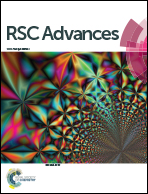Synthesis and adsorption properties of [Cu(L)2(H2O)]H2[Cu(L)2(P2Mo5O23)]·4H2O/Fe3O4 nanocomposites†
Abstract
Multifunctional [Cu(L)2(H2O)]H2[Cu(L)2(P2Mo5O23)]·4H2O/Fe3O4 (HL = pyridine-2-carboxamide) nanocomposites were successfully synthesized by combining [Cu(L)2(H2O)]H2[Cu(L)2(P2Mo5O23)]·4H2O and Fe3O4 nanoparticles. The characterization was performed by Fourier transform infrared spectroscopy (FTIR), transmission electron microscopy (TEM), vibrating sample magnetometry (VSM), X-ray powder diffraction (XRD) and ultraviolet-visible light absorbance spectrometry (UV-vis). The XRD and TEM analyses reveal that the nanocomposites possess high crystallinity with an average particle size of ∼19.43 nm. The VSM and UV-vis demonstrate excellent superparamagnetic behavior and two well-behaved absorption bands of the nanocomposites. The adsorption activity of the nanocomposites was investigated using methylene blue, gentian violet, safranine T, fuchsin basic, methyl orange and Sudan red (III) as probe molecules, and the results reveal that the [Cu(L)2(H2O)]H2[Cu(L)2(P2Mo5O23)]·4H2O/Fe3O4 nanocomposites have selective adsorption behavior for organic dyes. The recycling performance was observed using basic fuchsin, and the results demonstrate that the nanocomposites exhibit good recyclability and high stability. The [Cu(L)2(H2O)]H2[Cu(L)2(P2Mo5O23)]·4H2O/Fe3O4 nanocomposites have a promising future for magnetic, optical and biomedical applications.
![Graphical abstract: Synthesis and adsorption properties of [Cu(L)2(H2O)]H2[Cu(L)2(P2Mo5O23)]·4H2O/Fe3O4 nanocomposites](/en/Image/Get?imageInfo.ImageType=GA&imageInfo.ImageIdentifier.ManuscriptID=C7RA02133J&imageInfo.ImageIdentifier.Year=2017)


 Please wait while we load your content...
Please wait while we load your content...